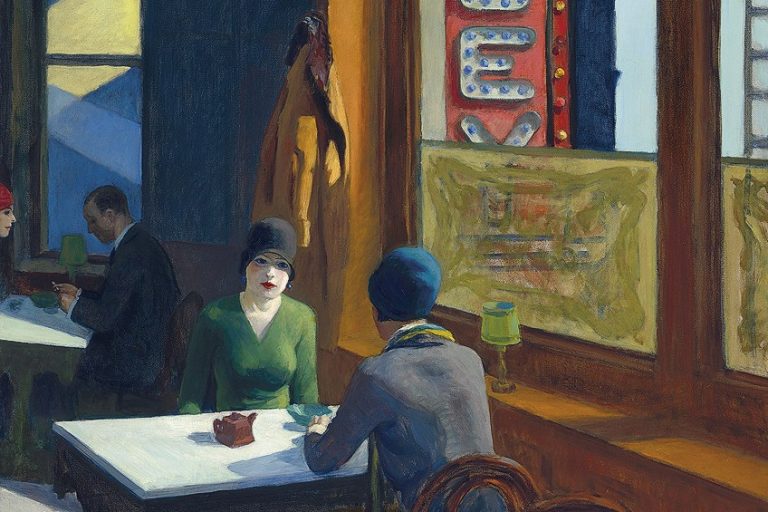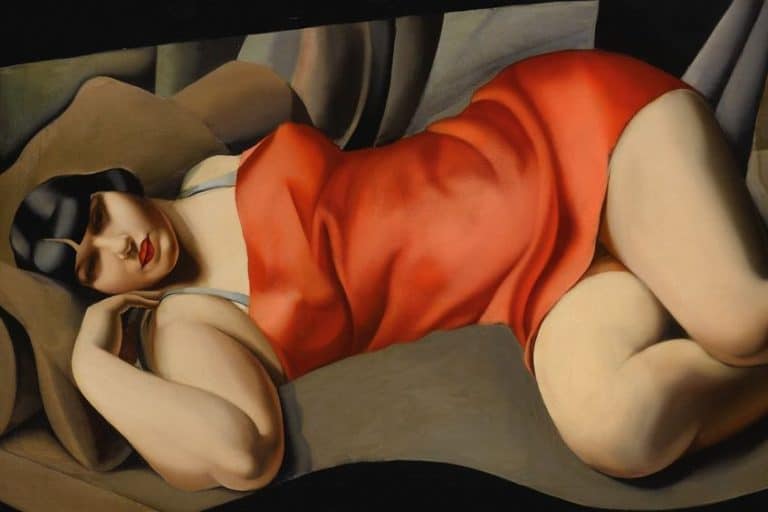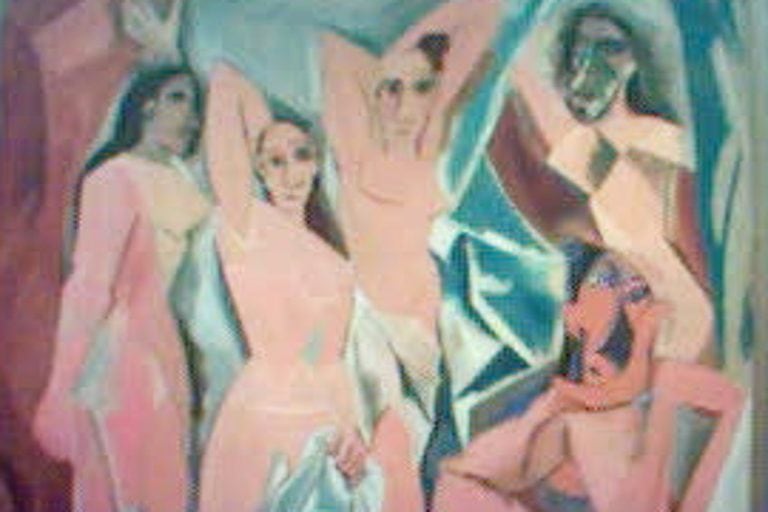“A Bigger Splash” by David Hockney – A Pool Painting Analysis
Imagine a summery day; it is hot outside, and all you want to do is jump in the pool and splash around. This article will discuss A Bigger Splash (1967) by David Hockney, which is equally enticing and mysterious, both still and full of life.
Artist Abstract: Who Was David Hockney?
David Hockney is a British contemporary artist well-known for partly creating within the Pop art style, but not exclusively. He is amongst the most “influential” English artists. He was born on July 9, 1937, in Bradford in Yorkshire, England, and studied at the Royal College of Art. He has lived in various cities in Europe and the United States of America, namely Los Angeles. He is multi-talented and creates within art modalities of painting, photography, printmaking, stage designing, and draftsmanship. His style has been influenced by Egyptian art, Renaissance art, Cubism, Abstract Expressionism, and more. His subject matter ranges from landscapes to portrait paintings, the latter would consist of his parents and friends, as well as inspiration taken from photographs.
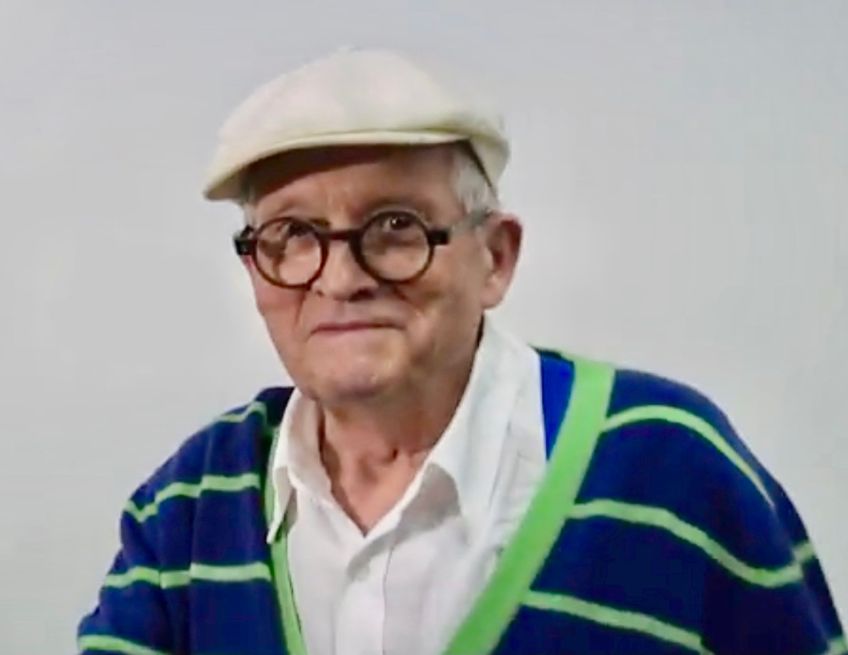
A Bigger Splash (1967) by David Hockney in Context
In the article below we will explore a contextual analysis of David Hockney’s A Bigger Splash painting, discussing why it was painted and what inspired it, as well as providing a formal analysis with a visual description of the subject matter and describing it in terms of the art elements and principles.
| Artist | David Hockney (1937 to present) |
| Date Painted | 1967 |
| Medium | Acrylic on canvas |
| Genre | Genre painting |
| Period / Movement | Pop art |
| Dimensions (cm) | 242.5 x 243.9 |
| Series / Versions | Part of three versions of Splash paintings |
| Where Is It Housed? | Tate Britain, London, United Kimgdom |
| What It Is Worth | Purchased in 1981 by the Tate Britain |
Contextual Analysis: A Brief Socio-Historical Overview
A Bigger Splash by David Hockney was painted in 1967, which was when the artist was living in California. It was the final and biggest version of three renderings of water splashing alongside the characteristic Californian natural and urban surroundings.
David Hockney’s previous splash paintings are namely, A Little Splash (1966), which is part of a private collection, and The Splash (1966), which is also part of a private collection. The Splash was reportedly sold in 2020 for $29.9 million; the buyer was not specified. A Bigger Splash was bought by the Marquis of Dufferin and Ava in 1968, which was part of John Kasmin’s art gallery, who was David Hockney’s art dealer since around 1961 and sold his paintings.
The Case Study Houses
It is interesting to note an important influence on David Hockney’s artwork was the Case Study Houses, which were houses built after World War II, from around 1945 to 1966. The houses were part of a program, so to say, for “modern” and “residential architecture”, and the idea was thought out by John Entenza, who was the editor for the magazine Arts & Architecture.
They were designed by several notable architects, and they were meant to be economical and easy to build, reportedly as solutions to shortages of housing post-war.
Entenza has been widely quoted as stating that the homes would be “capable of duplication”. David Hockney is also often quoted from one of his interviews that he went to Los Angeles for two reasons, one of which was “a photo by Julius Shulman of Case Study House #21”. In several of his paintings, these houses make an appearance, and undoubtedly the swimming pools, which were also common features.
The Significance of a Moment
David Hockney has often been quoted about his process of painting A Bigger Splash, explaining that when a splash is photographed the moment is frozen and it “becomes something else”, and that in real life a splash happens “too quickly” and cannot be seen that way in “real life”. He further stated that he was “amused” by that and “painted it in a very, very slow way”.
When he was asked the question about who may have jumped into the swimming pool, he explained that he didn’t know and that it was taken from a photograph that he did not take. He further explains what the image speaks about, that it is about “the stillness of an image”.
This also leads to the inherent irony in Hockney’s process of creating A Bigger Splash, in which he further explained, that he spent most of his time painting the splash, and “the splash lasts two seconds, and the building would be permanent there”. He also explained that that is what it was about and that “you have to look in at the detail”.
A Splash in Pop Culture
A Bigger Splash (1973), directed by Jack Hazan, is also the name of a documentary film based on David Hockney’s life and relationship, notably his breakup with Peter Schlesinger, who was also an artist and a model.
Schlesinger also posed for Hockney in some of his paintings, for example, “Peter Getting Out of Nick’s Pool” (1966) and “Portrait of an Artist (Pool with Two Figures)” (1972).
Formal Analysis: A Brief Compositional Overview
Below we will discuss the subject matter of A Bigger Splash by David Hockney in more detail, as well as outline it according to the art elements, namely color, texture, line, shape, form, and space.
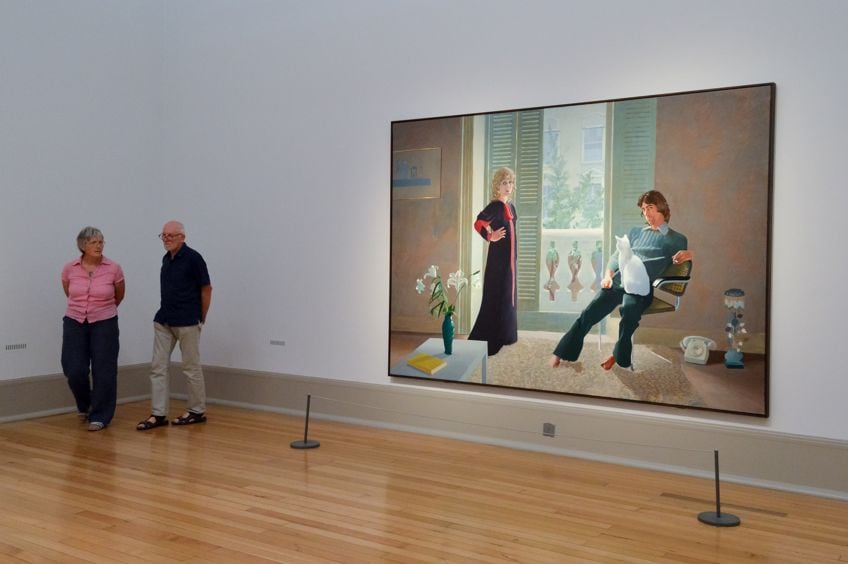
Subject Matter: Visual Description
David Hockney’s iconic pool painting depicts an outdoor scene, a summer’s day with a swimming pool, a house, palm trees, and a clear blue sky. In the lower half of the composition, the foreground, is a swimming pool and a yellow diving board protruding from the bottom right corner.
The water in the swimming pool is almost as clear blue as the sky above and appears motionless except for the large splash of water in front of the edge of the diving board as if someone just jumped into the pool, however, Hockney did not portray any figure, or figures in the composition, which gives the composition a more mysterious quality.
The upper half of Hockney’s pool painting depicts a patio that stretches the entire width of the swimming pool and leads out of the visible space on the left and right. On the patio to the left is a single folding chair that has crossed legs and is often referred to as a “director’s chair”. The patio and chair are situated in front of a house, which is also positioned on the left-hand side of the composition.
The house has a flat roof with large sliding doors composing about half of the house’s left façade, the other right half is an open wall space, which also has a strip of grass lining the bottom. There are curtains visible inside the house, however, nothing else is visible.
The glass doors reflect the buildings, palm trees, and other foliage on the other side of the composition, which is behind us, the viewers. This is a space that is not in our direct view but hints at the rest of the surroundings beyond the swimming pool. Next to the house, to the right, and reaching higher than the house, are two tall palm trees; the palm tree on the left is half-blocked by the house and the palm tree to the right is in full view.
Color
In A Bigger Splash, David Hockney utilized the medium of acrylic paint, which was reportedly the artist’s preferred medium due to it being fast drying. There are not too many colors, mainly the turquoise blues of the swimming pool water and the sky, the yellow of the diving board, and the more neutral, beige colors of the house, patio, and chair.
There are also small hints of green in the trees and grass and whites along the border of the house’s glass doors and roof. However, most of the white occurs as the larger area denoting the splash of water in the swimming pool.
Texture
The overall texture of the paint on A Bigger Splash appears as large and smooth areas of color, and reportedly Hockney started with large areas of paint, namely the sky, house, and swimming pool, which were applied to the canvas with a paint roller. Smaller areas of detail were applied with a paintbrush. Reportedly David Hockney spent two weeks creating the splash, which he did with small paintbrushes.
If you look closely at the splash of water you will notice the various types of brushstrokes, from dots to curved lines and squiggles and splotches, some are thick, thin, short, and long, and deliberately applied to create the texture of water.
Line
There is a variety of geometric and organic lines in A Bigger Splash by David Hockney, namely the straight horizontal and vertical lines of the house, the glass doors, the palm trees, as well as the swimming pool’s edge; diagonal lines are in the chair and diving board. Organic lines are in the palm tree’s leaves as well as the grass, but also notably in the water’s splash. The geometric and organic lines create contrast and emphasize the mood of the composition, which is seemingly still and quiet, motionless, which is contrasted by the movement of the lines created by the splash of water.
Shape and Form
Geometric shapes are evident in the horizontal rectangular shape of the house and diving board, and the vertical rectangular shapes of the glass doors. There is also a two-dimensionality in the manner that Hockney painted the building, which appears flat against the blue of the sky.
The splash of water appears more organic and “free” in its form, without any structure, which depicts more of a naturalism and how water would react and appear when someone has jumped into a swimming pool.
Space
In A Bigger Splash, David Hockney utilizes perspective in the manner he angles the diving board to the right of the composition. The diving board is also larger in size due to it being in the foreground and compared to the chair in the background, which appears smaller, there is a sense of receding space and depth created.
The compositional space also appears almost as if Hockney took a photograph, and interestingly the artist was inspired by a photograph that he saw in a book about swimming pools. For example, the border around the painting has been left as the “raw canvas”, which has been likened to how a polaroid photograph looks.
David Hockney: Bigger and Bigger
David Hockney, who is currently 85 years old and residing in Normandy, has become one of the leading names of British artists, exploring and delving into numerous themes throughout his artistic oeuvre. He has received several awards and accolades throughout his lifetime, some of these include the Order of Merit in 2012, the Lifetime of Artistic Excellence Award from the Pratt Institute in 2018, as well as the Distinguished Service to Art award by the Critic’s Circle, also in 2018.
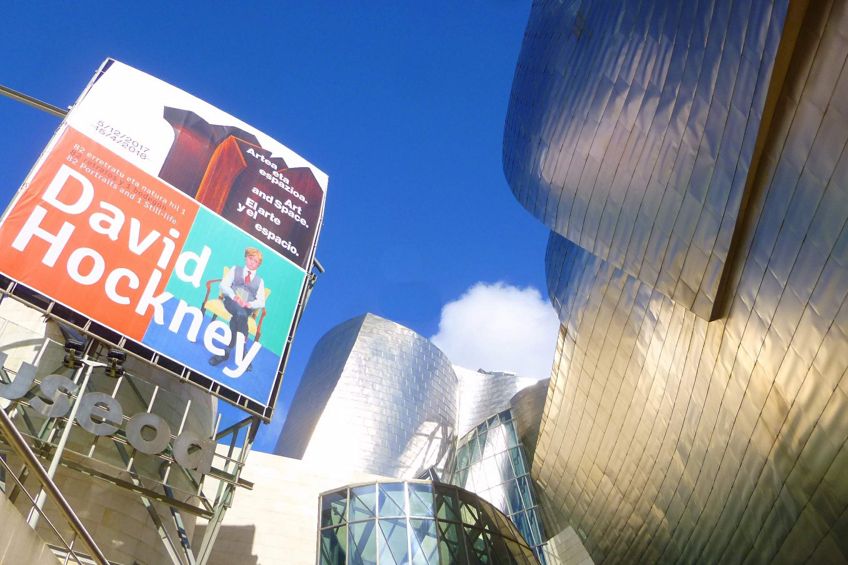
That same year, Hockney was also commissioned by the Dean of Westminster to design a stained-glass window for Westminster Abbey in London, England in honor of Queen Elizabeth II. The design centers around the countryside and notably because of the Queen’s love of it.
In this article, we touched on David Hockney’s famous pool painting A Bigger Splash, which was part of a series of three similarly themed paintings. We explored only the surface of the depths of what he loved to convey, which were often themes around everyday people and places, as well as the distinct Californian urban landscape, and through his artistic medium, which was acrylic paint – all of which have become Hockney’s trademark style and is certainly difficult to miss.
Frequently Asked Questions
Who Painted the Famous Splash Painting?
The British artist David Hockney created the famous acrylic on canvas splash painting, which is titled A Bigger Splash (1967). It is the latter iteration of three versions, the first two of which are called The Splash (1966) and A Little Splash (1966).
Where Is A Bigger Splash by David Hockney?
A Bigger Splash (1967) by David Hockney is housed at the Tate Britain art gallery in London, England. The Tate bought the artwork in 1981 from the Marquis of Dufferin and Ava, also known as Sheridan Dufferin.
What Influenced A Bigger Splash Painting by David Hockney?
David Hockney’s A Bigger Splash (1967) painting was partly inspired by a photograph of a pool he found in a book as well as the influence Los Angeles had on him when he traveled there in 1963, notably the architecture, climate, and relaxed way of life. Reportedly, the house was based on Hockney’s drawings of a California-styled house.
Alicia du Plessis is a multidisciplinary writer. She completed her Bachelor of Arts degree, majoring in Art History and Classical Civilization, as well as two Honors, namely, in Art History and Education and Development, at the University of KwaZulu-Natal, South Africa. For her main Honors project in Art History, she explored perceptions of the San Bushmen’s identity and the concept of the “Other”. She has also looked at the use of photography in art and how it has been used to portray people’s lives.
Alicia’s other areas of interest in Art History include the process of writing about Art History and how to analyze paintings. Some of her favorite art movements include Impressionism and German Expressionism. She is yet to complete her Masters in Art History (she would like to do this abroad in Europe) having given it some time to first develop more professional experience with the interest to one day lecture it too.
Alicia has been working for artincontext.com since 2021 as an author and art history expert. She has specialized in painting analysis and is covering most of our painting analysis.
Learn more about Alicia du Plessis and the Art in Context Team.
Cite this Article
Alicia, du Plessis, ““A Bigger Splash” by David Hockney – A Pool Painting Analysis.” Art in Context. January 30, 2023. URL: https://artincontext.org/a-bigger-splash-by-david-hockney/
du Plessis, A. (2023, 30 January). “A Bigger Splash” by David Hockney – A Pool Painting Analysis. Art in Context. https://artincontext.org/a-bigger-splash-by-david-hockney/
du Plessis, Alicia. ““A Bigger Splash” by David Hockney – A Pool Painting Analysis.” Art in Context, January 30, 2023. https://artincontext.org/a-bigger-splash-by-david-hockney/.




